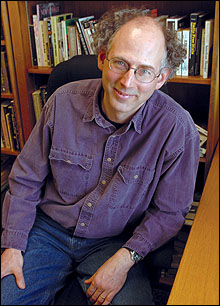Archives
Race, urban studies are his passion
Nightingale is ’sewing’ life together in Buffalo
By JESSICA KELTZ
Reporter Contributor
Carl Nightingale says he's always favored an interdisciplinary approach in his work, so leaving a history department at another university to join the UB Department of American Studies as an associate professor was a great choice for him.

Historian Carl Nightingale has joined with the department of American Studies, where he plans to continue his work on race and urbanism.
PHOTO: NANCY J. PARISI
"I was trained as a historian of cities and American culture and politics, and I've always been very interdisciplinary in my approach to these topics," says Nightingale, who taught for 11 years at the University of Massachusetts-Amherst. "So coming to an American Studies department only made sense."
Nightingale also moved to Buffalo to join his wife, Martha McCluskey, a professor at the UB Law School. But, he says, Buffalo is a good fit for his work because so many of the topics he studies—race, segregation and the history of urbanism, to name a few—are prevalent issues in local communities in Western New York.
Nightingale's first book, "On the Edge: A History of Poor Black Children and Their American Dreams," looked at the lives of children growing up in inner-city Philadelphia. He considers his approach, which included living in the neighborhood he studied and starting a community organization there, to have combined elements of ethnography with more traditional historian work.
The community organization met at his house and included a youth court, mentoring, tutoring and recreation programs. Although Nightingale left Philadelphia in the early 1990s, the organization remained intact until the children it served grew up, he says, pointing out that he still keeps in touch with people in the neighborhood and that while some of the kids have spent some time in prison, others have graduated from college.
Nightingale, who received his Ph.D. from Princeton University, has since developed an interest in world history, and looks forward to teaching a section of UB's World Civilization course. He currently is working on a book that he says will examine American urban issues from a global perspective. Called "Race in the City: A World History of Urban Color Lines," he explains that it looks at how first color, then race, were used to divide cities over the past 300 years. This work has involved research in Europe and South Africa, as well as the U.S. and it will take him to India later this year.
"I'm trying to understand the connection between segregation and racial inequality, and I'm interested in ways cities can become part of a global system to create institutions that are racially unequal," he says. "When we think of the driving forces of global inequality, we tend to focus on the work of giant corporations, financial institutions and powerful national governments. My book explores the mutual connections between the politics of urban racial segregation, the international commerce in racial ideas and global dynamics of institutional racial inequality."
In addition to "On the Edge," he has published a series of articles, essays and reviews, and he coordinates the Buffalo Seminar on Racial Justice, a working group of the Baldy Center on Law and Social Policy in the UB Law School. Through the Baldy Center group, he has organized two conferences on issues of mutual concern to academics and activists. Most recently, Gregory Squires of George Washington University, Guy Stuart of Harvard University and Audrey MacFarlane of the University of Baltimore Law School traveled to Buffalo to address "Overcoming Racial Discrimination in Housing, Credit and Urban Policy" on April 7. The seminar also holds four public meetings a year, where people from the community, including law professor Athena Mutua and Frank Mesiah, head of the local NAACP chapter, have spoken.
Nightingale explains that there are three photographs on his office door in Clemens Hall. "One is of a sign of 'Race Street' in Philadelphia, another of 'Urban Street' in Buffalo. The third photo is of a surveyor's spray paint on a Milwaukee sidewalk that says 'Global X-ing.'
"Race. Urban. Global. That's the basic recipe for my work," he says.
Nightingale lives in the Parkside neighborhood of North Buffalo with his wife and their 4-year-old daughter, who was born in South Africa. He notes that making everyday decisions, such as where to live and where to send his daughter to school, make it impossible for him not to be engaged in the community.
"We really wanted a school that didn't just pay lip service to diversity," he says, but at the same time he and McCluskey didn't want to compromise on the quality of education. His daughter will go to Montessori 78, a Buffalo public school on the East Side.
Nightingale says that Buffalo is an ideal place for his work, even with all its colossal problems.
"You have to love Buffalo, and you have to hate it," he says, noting the city's history of segregation and ethnic divisions, as well as UB's commitment to civic engagement. "Basically, my life and my work can be very neatly and also very messily sewn together here."
In addition to his work and family, Nightingale enjoys taking photographs of city scenes in Buffalo and taking students on tours of the city.
"Urban landscapes interest me aesthetically, as well as for their politics," he says.
